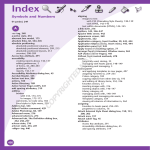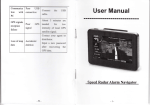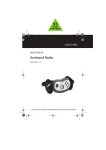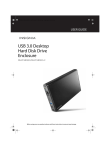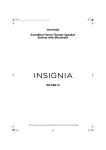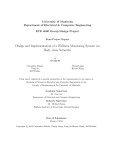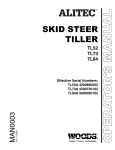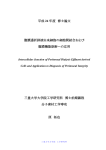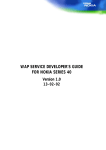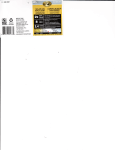Download / ——“2E%%ED / 521 HTTP
Transcript
US008418056B2 (12) United States Patent (10) Patent N0.: Stinson et al. (45) Date of Patent: (54) METHOD AND APPARATUS FOR roWn et a . 2003/0115365 A1 E-COMMERCE APPLICATION 6/2003 Lindsey 2003/0135560 A1 Inventors: Charles Laurence Stinson, Mississauga _ . . ( (73) . 2004/0221063 ) A1 11/2004 2007/0250711 A1* 10/2007 Storey .......... .. 11/2007 2007/0263841 A1 ll/2007 Li Subject to any disclaimer, the term of this patent is extended or adjusted under 35 Siau et 211., “Building Customer Trust in Mobile Commerce”, ACM, 2003, PP 9194* Iet22(1)l(,)9“Usabliliiy*Evaluation of OpenWeb Transcoding”, 0 1 e , , PP~ - ~ (21) Appl. No.: 12/016,476 Filed: 713/168 McBride et a1. ............ .. 709/246 OTHER PUBLICATIONS U_S_C_ 154(1)) by 878 days_ (22) Mogul 2007/0255852 A1* Assignee: Research In Motion Limited, Waterloo Notice: Pirhonen et a1. .............. .. 705/53 8/2004 Omar et a1. .............. .. 455/4141 2004/0230536 A1* 11/2004 Fung et a1. .................... .. 705/64 (CA) (*) 11/2003 2004/0166834 A1* (gf’ sang Helm Klm’ Mlsslssauga ............... .. 7/2003 Bodin 2003/0220881 A1* . Apr. 9, 2013 5885;852:232 2}: Z588; PBIWmg e‘ a} ~~~~~~~~~~~~~~~~ ~~ 383/22 CHECKOUT TRANSITION IN AN (75) US 8,418,056 B2 (Continued) Jan- 181 2008 _ Primary Examiner * Doug Hutton, Jr. _ _ Assistant Examiner * James DebroW (65) Pnor Pubhcatlon Data US 2009/0187820 A1 Jul. 23, 2009 (74) Attorney, Agent, or Firm * Bennett Jones LLP (51) Int‘ Cl‘ G06F 17/24 G06F 17/25 A method and apparatus for transcoding content or elements of a Webpage received at a client device, for example, a mobile communication device or other type of networked (57) (52) (200601) (2006-01) US. Cl. ...................................... .. 715/238; 715/248 (58) Field Of Classi?cation Search ................. .. 715/238 ABSTRACT device The apparatus includes a transcoding engine Which is con?gured t0 transcode Webpage content during a secure See application ?le for Complete Search history. end-to-end connection between a client device and a Website Without the use of a proxy. According to an embodiment, the (56) References Clted transcoding engine resides on the client, and is implemented as a plug-in to the broWser, and transcoding instructions are U.S. PATENT DOCUMENTS 6,970,602 B1 ll/2005 Smith et a1. provided to the client device by Way of the signature ?le(s) each time the plug-in is invoked. The client device uses the 6,970,918 B2 * 11;2005 BTOWP et a1~ 913;’; * 732133072 B2 é / transcoding instructions to manipulate the secure response E3132; """"""""""" " 3‘ 5/2007 coulombe'e't' from the secure server, for example, to transcode the response """""" " to a format suitable for display on the Client device. 7,788,577 B2 * 8/2010 7,904,487 B2 * 3/2011 Ghatare ...................... .. 707/803 Lueck ......................... .. 715/239 RENDERING CL'ENT 15 Claims, 12 Drawing Sheets CLIENT TRANSCODER VENDOR'S WEBSERVER PROXY TRANSCODER/ SIGNATURE REPOSITORY 520 / ——“2E%%ED / 521 /523 5:22 HTTP RESPONSE HTTP REQUEST HTTP COMMUNICATION / \ <__ TRRéggg?ggo 502 51 O SECURE / 511 REQUEST O REQGUEST F RS1 NATURE_: HTTPS RESPONSE COMMUNICATION 501 3 \ C7 TRANSCODED QT RESPONSE 51 7 512 T HTTPS 51%‘ REQUEST Q, 516 HTTPS RESPONSE / 515 US 8,418,056 B2 Page 2 OTHER PUBLICATIONS Chang, Yuan-Chi et al.; Secure Transcoding of Internet Content; http://WWW.cs.colorado.edu/~rhan/IMMCN005 .pdf; Hawthorne, NeWYork, U.S.A. Kitson, Fred; Mobile Media: Making it a Reality; Mobile Applica tions; vol. 3, No. 4iMay 2005. Knutsson, Bjorn et al.; Architecture and Performance of Server Directed Transcoding; Acm Transactions on Internet Technology, vol. 3, No. 4, Nov. 2003, pp. 392-424; Pennsylvania U.S.A. Usablenet Assistive User’s Manual; 2004-2007 Usablenet Inc. NeW York, NeW York; htrnl#protocols. Lift Assistive User’s Manual; Version 2.0 for Sun Solaris; WWW. usablenet.com; NeW York, U.S.A. * cited by examiner http://teXt.rochester.edu/tt/user-help. US. Patent Apr. 9, 2013 _ Sheet 1 0f 12 US 8,418,056 B2 132-2 VENDOR WEBSITE VENDOR WEBSITE 120 112 / <-> SERVER 114 / WIRELESS GATEWAY w [116 WIRELESS k1 1 8 INFRASTRUCTURE (6% ((< D3 A 110 / RF A RF . 1 US. Patent Apr. 9, 2013 Sheet 2 0f 12 US 8,418,056 B2 /130 (Q >33 DISPLAYMODULE J242 240 (Q )9 RF 252 KEYBOARD \ A (Q93 :5 r250? RF A “0 210 / 24\4 ->/\ CIRCUITS“> CPU \/ e V230 220 \ 2/22 BROWSER DATA MEMORY 241 US. Patent Apr. 9, 2013 Sheet 6 0f 12 US 8,418,056 B2 /800 futureshop.ca I» FUTURESHOP | LOGIN TO YOUR ACCOUNT —‘|_/81 0 PLEASE SIGN IN TO ACCESS YOUR ACCOUNT. IF YOU DO NOT HAVE AN ACCOUNT, IT ONLY TAKES A FEW MOMENTS TO CREATE ONE. 830 LOGIN NAME; —/820 l PASSWORD: \ | > l::! |/— 832 822 FIG. 8 _Fulura Shop - Mozllla Flrefox Elle Edi! Mew Him Bnlmurls Iools Heb Q Q » mwwmmmmmwpmiumpmamweu } » l-IIIII » Wm » ml‘ » mum Search by Emn slu Amount lnformmn Craalea nswacmunl * m v Login to your account Pbasesignhtoacuessyuua 1 l. llyuu dunothavemawuuntllunlyialssafenmmwmsm WWZ'Q“ 620L610 Information Cgnh'g R blrll'l ur- I|| lrlonnlinncantmz m 54-91. I: In sum“; ywrnl ‘ 632 Ourqnlna p?iu » Lowest price quaranteedlgllgkmm I: w » : . run’ n In; - ma; ; I w. my gw... O I W“; m : : , , an :: m VlI'n?hyVlSA - 5"” l I iml?l l l'fd ? me FIG. 6 US. Patent Apr. 9, 2013 Sheet 7 of 12 Future Shop 5,; edge Rail] »FUTURESHOP Z5 <9 WEEKLY FLYER @ LOCATOR STORE IE] EXPERT ADVICE m CLEARANCE mCOMMUNITY OUTLET FORUM "I, g edge Edi] Future Shop » LOGIN » MY ORDERS » ACCOUNT P’ CREATE NEW ACCOUNT » FRANCAIS Shop by department Com uters Com uter Add-Ons I I Brand Showcase Hewlett Packard Future Shop ‘,5 edge Rail] Software Photo Photo Finishin TV & Video Audio Satellite Radio Car Audio / Video & GPS MP3 Pla ers/ Portable Electronics Phone & PDA’s Lo itech Microsoft S mantec FIG. 7(i) US 8,418,056 B2 US. Patent Apr. 9, 2013 Future Shop Sheet 9 0f 12 US 8,418,056 B2 ‘La edge M £2 Navigating Seach helg Quulnmm?i Web site use agreement Privacy golicy MW. shogging Shigging and delivegr My orders Contact us Future Shop ‘,5 edge Veri?ed by VISA Future Shog mew Email fraud Oniine Future Shog credit disclosures Retail store golicies Product Service M ReClaim Insurance Reglacement ln-Stor Pickug FIG. 7(iii) US. Patent Apr. 9, 2013 Sheet 10 0f 12 Future Shop US 8,418,056 B2 “,5 edge 2:111] I Login to your account ‘ Please sign in to access your account. If you do not have an account, it only takes a few moments to create one. Login name: ( Remember - it's your email!) Password: Forot our assword? Future Shop “,5 edge Edi] }} Lowest price guaranteed! Click here » New visitor? Click here to create a ‘ new account. Help Centre Company Services FIG. 7(iv) US. Patent Apr. 9, 2013 Sheet 11 0f 12 A US 8,418,056 B2 N (:17 BlackBerry » FUTURE SHOP Acer Aspire AMD Tu ‘ n 64 X2 Dual Cor TL52 1.6 GHz Laptop (AS 0-5390) ( $999.99) AcerAspire Intel Core Duo T2060 1.6GHz Laptop (AS9410-2028) ($849.99’ Toshiba Satellite Intel Cent ' Core Duo T235D 1.86GHz Laptop (P MB) ($1299.99) SAMPLE MOBILE APPLICATIQN - CONTENT FIG. 9 US 8,418,056 B2 1 2 METHOD AND APPARATUS FOR CHECKOUT TRANSITION IN AN E-COMMERCE APPLICATION FIG. 2 shoWs in schematic form an exemplary mobile Wireless communication device Which is capable of commu nicating Within the netWork environment of FIG. 1; FIG. 3 shoWs in diagrammatic form a mobile communica tion device and server con?guration according to an embodi A portion of the disclosure of this patent document con ment; FIG. 4 shoWs in diagrammatic form the mobile communi tains material Which is subject to copyright protection. The copyright oWner has no objection to the facsimile reproduc tion by any of the patent document or patent disclosure, as it appears in the Patent and Trademark O?ice patent ?le or cation device and server con?guration of FIG. 3 With transcoder ?oW according to an embodiment; FIG. 5 shoWs in schematic form transcoder How in relation records, but otherWise reserves all copyright rights. to a client according to an embodiment; FIG. 6 shoWs a screen shot of an exemplary login Webpage FIELD OF THE APPLICATION for an e-commerce or vendor Website designed for a personal The present application relates to e-commerce, and more particularly, to a method and apparatus for checkout transi computer (PC) display monitor; tion in an e-commerce transaction for a mobile communica login Webpage for an e-commerce or vendor Website of FIG. 6 rendered on the display module of the mobile communica FIGS. 7(1') to 7(iv) shoWs screen shots of the exemplary tion device in a Wireless packet data service netWork. tion device of FIG. 2; FIG. 8 shoWs a screen shot of an exemplary e-commerce BACKGROUND OF THE APPLICATION 20 FIG. 9 shoWs a screen shot of an application rendered on Websites pages can generally be separated into distinct functionsidisplaying content and navigation. Web pages typically have both of these functions on each page and Will display content in the main content areas and have navigation options through menus. For example, Web pages in e-com merce applications are typically designed for use PC based Web broWsers having 800x600 or higher screen resolutions. This layout makes sense for desktop broWsers since the screens are large enough to display the entire page. HoWever most mobile broWsers do not have the Width and height of a login page With transcoding according to an embodiment; the display module of a mobile communication device; and FIG. 10 shoWs a screen shot of the application of FIG. 9 With a menu rendered on the display module of a mobile 25 communication device. Like reference numerals indicate like or corresponding elements in the draWings. 30 DETAILED DESCRIPTION OF THE EMBODIMENTS typical PC monitor, therefore they are unable to display pages as they Would appear on a PC broWser. One approach to deal With this is to re-organiZe the page and Wrap content around the screen. A second approach often used by the WAP stan dard is spatially divide a page (usually vertically) into a num ber of pages and alloW users to navigate betWeen each page section to vieW a page. In a further example, large headers and Embodiments of the present invention are generally 35 the method comprises the steps of: requesting the Webpage menus force a user to scroll considerable lengths before reaching content speci?c to the Web page being vieWed. An exemplary e-commerce login page designed for a PC-based Web broWser is shoWn in FIG. 6 and using conventional techniques the Webpage of FIG. 6 is rendered on the display from the Website server; establishing a communication link 40 instructions; transcoding the received portion of the Webpage of a mobile communication device in multiple screens as 45 art. 50 server over a communication netWork, the mobile communi cation device comprises, a component con?gured to request the Webpage from the Website server; a component con?g tent or Webpage element(s), for a mobile communication device in a Wireless packet data service netWork. Other aspects and features Will become apparent to those ordinarily skilled in the art upon revieW of the folloWing description of embodiments in conjunction With the accom according to the one or more transcoding instructions; and generating a page suitable for display on the mobile commu nication device based on the transcoded Webpage. According to another broad aspect, there is provided a mobile communication device con?gured for displaying a page generated from a Webpage received from a Website SUMMARY The present application is directed generally to a method and apparatus for transcoding Web pages, for example, con directly betWeen the Website server and the device; receiving at least a portion of the Webpage over the communication link With the Website server; obtaining one or more transcoding depicted in FIGS. 7(1') to 7(iv). Accordingly, there remains a need for improvements in the directed to a method and system for transcoding Web pages or Web content for a mobile communication device. According to one broad aspect, there is provided a method for generating a page suitable for display on a mobile com munication device based on a Webpage from a Website server, 55 panying ?gures. ured to establish a communication channel directly betWeen the Website server and the device; a component con?gured to receive the Webpage over the communication channel; a com ponent con?gured to retrieve one or more transcoding instructions; a transcoding engine con?gured to execute the one or more transcoding instructions to transcode content in the received Webpage; and a component con?gured to render BRIEF DESCRIPTION OF THE DRAWINGS 60 Reference Will noW be made to the accompanying draW ings Which shoW, by Way of example, embodiments of the methods and systems described herein, and hoW they may be carried into effect, and in Which: FIG. 1 shoWs in diagrammatic form an exemplary netWork environment suitable for operating an embodiment according to the present application; 65 a page suitable for display based on the transcoded content. According to further broad aspect, there is provided a com puter program product for generating a page suitable for display on a mobile communication device, the computer program product comprises, a storage medium con?gured to store computer readable instructions; the computer readable instructions include instructions for, requesting a Webpage from a Website server; establishing a communication link US 8,418,056 B2 3 4 directly between the website server and the device; receiving comprises a central processing unit or CPU 210. The CPU 210 operates under the control of a program (i.e. ?rmware or software) stored in program memory 220. The CPU 210 is also provided with data memory 230. The CPU 210 is also operatively coupled to a keyboard 240 and a track wheel 241 or a trackball 243 (shown in broken outline), a display module 242 and an audio transducer or speaker 244. In addition to the at least a portion of the webpage over the communication link with the website server; obtaining one or more transcoding instructions; transcoding the received portion of the webpage according to the one or more transcoding instructions; and generating a page suitable for display on the mobile commu nication device based on the transcoded webpage. According to a yet another broad aspect, there is provided a mechanism for changing the layout of a web page indepen dently of the web server, and allowing the client to optimiZe program executable code providing for performing the func tions associated with the operation of the mobile communi the web page content and/ or underlying user interface accord browser program 222. The browser program 222 allows a user ing to the requirements or characteristics of the client’s device. Reference is ?rst made to FIG. 1, which shows in diagram matic form an exemplary network environment 100 wherein an embodiment as described herein may be practiced. The network environment 100 comprises a wireless network 110, the Internet 112, a wireless gateway 114, a wireless infra to access web pages (i.e. HTTP browsing) on the Internet 112 structure 116, and a server 120. The wireless network 110 serves a plurality of users, each having a mobile communi cation device 130, the program memory 220 includes a using the mobile communication device 130, ie utiliZing a graphical user interface comprising, for example, the key board 240 and the display module 242 and/ or the track wheel 241 (or the trackball 243). HTTP browsing comprises using HTTP (Hypertext Transfer Protocol) which comprises a 20 cation device 130, indicated individually as 130-1, 130-2, . . . 130-11. The wireless gateway 114 and the wireless infrastructure 116 provide a link between the Internet 112 and the wireless network 110. The wireless infrastructure 116 determines the most likely network for locating a given user and tracks the request response protocol in which parameters a request are set before the request is sent. According to an embodiment, the mobile communication device 130 indicates another browser or browser module which is con?gured to transcode secure content, for example, from a secure HTTP (HTTPS) connection, as will be described in more detail below. The browser 322 may be implemented in the device 130 as a 25 separate module or integrated with the browser program 222. As shown, the mobile communication device 130 includes users as they roam between countries or networks. A message a RF, demodulation/modulation and decoding/coding circuits is then delivered to the mobile communication device 130 via 250, and a suitable RF antenna 252. The RF demodulator/ modulator and decoder/coder circuits 250 and the RF antenna 252 are operatively coupled to the CPU 210 and provide an interface for wireless communication with the wireless net wireless transmission, typically at a radio frequency (RF), from a base station in the wireless network 110 to the mobile 30 device 130. The wireless network 110 may comprise any wireless network over which messages may be exchanged with a mobile communication device. The wireless infrastructure 116 includes a series of con nections to the wireless network 110. These connections work 110. The particular implementation details of the RF circuits will be within the understanding of those skilled in the art, and is therefore not described in further detail. 35 could be Integrated Services Digital Network (ISDN), Frame Relay or T1 connections using the TCP/IP protocol used using the graphical user interface (i.e. the display 242, the keyboard 240 and/or a thumb-operated track wheel 241) throughout the Internet. As used herein, the term “wireless network” is intended to include three different types of net works, those being (1) data-centric wireless networks, (2) enters the URL or a bookmark for a website of interest, for 40 voice-centric wireless networks and (3) dual-mode networks same physical base stations. Combined dual-mode networks include, but are not limited to, (1) Code Divisional Multiple returns the requested or corresponding webpage to the mobile Access (CDMA) networks, (2) the Group Special Mobile or the Global System for Mobile Communications (GSM) and the General Packet Radio Service (GPRS) networks, and (3) future third-generation (3G) networks like Enhanced Data communications device 130. Similarly, if the user wishes to access another website, for example, http://www.bestbuy.ca, rates for Global Evolution (EDGE) and Universal Mobile Systems (UMTS). Some older 50 examples of data-centric networks include the MobitexTM Radio Network and the DataTACTM Radio Network. Examples of older voice-centric data networks include Per described in more detail below. According to an embodiment, HTTP requests are made using a HTTP connection and the 55 transcoding browser 322 (FIG. 3) is invoked if an HTTPS request is encountered, where the HTTPS request initialiZes the transcoding engine 324 (FIG. 3) described in more detail below. 60 cally referred to as the “user agent”. The destination server stores resources, such as, HTML ?les and images, and is typically referred to as the “origin server”. Inbetween the user agent and the origin server there may be several intermediar 65 present application, the mobile handheld devices 130 com prise user agents, the server 120 comprises an intermediary server, and the web servers 132 comprise origin servers. The server 120 may be implemented, for example, on a network computer for a corporate entity, a computer within an ISP system or as part of a public server infrastructure. The The originating client, for example, a web browser, is typi server 120 provides an interface for web access on the Internet 112 for mobile communication devices 130 equipped with a browser or having browser capability as will be described in more detail below. An embodiment of the server 120 is described in more detail below. The server 120 may be imple mented behind a ?rewall indicated by reference 1 18 in FIG. 1. Reference is next made to FIG. 2, which shows in more detail an exemplary implementation of the mobile communi cation device 130. The mobile communication device 130 on web server 132-2, the HTTP request from the mobile communication device 130 is relayed by the server 120 to the web server 132-2. If the requested webpage comprises an HTTPS connection, then the browser 322 is invoked to transcode secure or encrypted content or elements as sonal Communication Systems (PCS) networks like GSM, and TDMA systems. example, http://www.futureshop.ca. The browser 222 con verts the user entry into a HTTP request and sends the request to the server 120. The server 120 relays the HTTP request to the web server, for example, web server 132-1 for “future shop.ca”. In response to the request, the web server 132-1 that can support both voice and data communications over the Telecommunications To locate an e-commerce site, the user invokes the browser program 222 in the mobile communication device 130 and ies, for example, proxies and gateways. In the context of the US 8,418,056 B2 6 5 information de?ning a layout for presenting the relation According to an embodiment, the intermediary server is ship betWeen the object(s) and attribute(s) located or con?gured behind a ?rewall. Reference is next made to FIG. 3, Which shoWs in diagram For mobile communication devices 320 that do not provide matic form a mobile communication device and server con full support for JavaScriptTM constructs, the signature ?le is ?guration according to an embodiment and indicated gener ally by reference 300. The system 300 as shoWn comprises a implemented With transcoding instructions that mimic J ava server 310 Which is linked or communicates With a mobile redirecting to another page, changing location of a frame or handheld device 320. As Will be described in more detail beloW, the server 310 may be integrated or associated With an altering attributes of HTML tags. ScriptTM calls, such as, submitting a form, setting variables, The broWser 322 provides the user interface (UI) for the mobile device 320 (i.e. the client). The broWser 322 commu intermediary server. According to another embodiment, the server 310 may be implemented as a stand-alone module or nicates With the vendor Website 330 and other Web servers to device. The server 310 couples the mobile handheld device fetch Web pages, for example, using HyperText Transfer Pro 320 to a vendor Website or e-commerce site indicated gener tocol or HTTP. According to an embodiment and as shoWn in ally 330. According to an embodiment and as shoWn in FIG. 3, the mobile handheld device 320 includes a broWser 322 and a transcoding engine 324. According to an embodiment, the transcoding engine 324 resides Within the broWser 322 and is layered just before the parsing/rendering of the HTML con tent. According to an embodiment, the transcoding engine 324 is initialized With transcoding instructions. According to an embodiment, the transcoding instructions are requested FIG. 3, a request, i.e. HTTP and HTTPS, is initially made using a standard HTTP connection, for example, as indicated by reference 302 in FIG. 3 and reference 502 in FIG. 5. The broWser 322 is implemented to broWse (e.g. receive) Web pages With unencrypted content from the Website 330 utiliz 20 ing an HTTP connection reference 3 02 via the server 3 1 0. The server 310 may be con?gured to transcode or convert the over a secure link, eg a secure HTTP connection or HTTPS, unencrypted (e.g. HTTP) responses received from the Web from the server 31 0 and remain on the mobile communication site 330 into a format suitable for display on the device. According to an embodiment, a communication channel or device 320, i.e. the client, for each subsequent secure request. According to an embodiment, the transcoding engine 324 has a lifespan that begins during the initialization process of 25 connection indicated by reference 304 in FIG. 3 and reference 501 in FIG. 5, is utilized if the transcoding engine 324 has been initialized. The transcoding engine 324 may be initial ized, for example, if a signature ?le is doWnloaded. According 30 prises a direct or end-to -end connection and may according to receiving and processing transcoding instructions and ends When an end instruction is received or a page that has no instruction is encountered. According to another embodi ment, the transcoding instructions are received from another to an embodiment, the communication channel 304 com source or stream, for example, installed on the device or read an embodiment further comprise a secure communication channel or connection, such as, an HTTPS connection. from a ?le stored in memory on the device. According to an embodiment, the transcoding engine 324 According to an embodiment, the HTTPS connection 304 is is responsible for interpreting and executing the transcoding instructions, i.e. applying the transcoding instructions to con 35 tent or Webpage elements received from the Website 330 as described in more detail beloW. The transcoding instructions may be static or dynamic, and identify content to be extracted, as Well as de?ning the reorganization of the extracted content, for example, in a mobile friendly manner. Upon completion of the transcoding, the transcoding engine 324 creates a neW 40 input stream, Which replaces the original content received over the secure socket from the vendor Website 330, and the neW input stream is passed to the broWser 322, i.e. the ren dering engine. con?gured to permit transcoding of SSL/TLS Without violat ing end-to-end security. For example, the HTTPS connection is con?gured to provide: (a) the capability to read the con nection before passing it to the rendering component; (b) the capability to alter the contents of the connection. Referring still to FIG. 3, the HTTP connection 302 com prises an unsecure or open communication path. For example, the broWser 322 generates a page request 340 Which is received by the server 310 and transmitted in a page request 342 to the Website 330. The server 310 receives a response 45 page 343 from the Website 330, Which is then transmitted to According to an embodiment, the content from the Website 330 is treated in terms of pages and the pages may be orga the broWser 322 as a response page 345. The broWser 322 may nized or categorized in families. Each family of pages is identi?ed by a signature, for example, in the form of a signa ture ?le. According to an embodiment, the signature ?le is stored on the server 310 and indicated generally by reference 314. According to an embodiment, the signature identi?es a 330 via the server 310. As shoWn, the server 310 includes an also be implemented to receive cookies 347 from the Website engine 312. The engine 312 is con?gured to manage the 50 signature ?les 314, i.e. as described above and in more detail beloW. According to embodiment, the broWser 322 may com prise a more generic broWser implementation, and can be given page on a Website as part of a family, and can also serve implemented as a component or module of the broWser pro to differentiate that family from another family of pages. gram 222 (FIG. 2). According to another aspect, object(s) and attribute ?eld(s) 55 The server 310 hosts or stores signature ?le(s) 314, and the can have a unique signature Within a family of pages. The signature ?le(s) 314 comprise transcoding instructions, signature ?le comprises transcoding instructions, i.e. instruc Which are used by the transcoding engine 324 on the mobile tions for transcoding Webpage content from the Website 330 for rendering and display at the mobile communication device 320. According to one embodiment, the signature ?le comprises the folloWing information or data: an identi?er for the page family, for example, lo gin, signup communication devices 320 to transcode Web pages or con tent received from the Website on the direct end-to-end or secure communication path 304, as described in more detail 60 beloW. According to an embodiment, the communication path 304 comprises a secure HTTP connection or HTTPS, and the transcoding engine 324 utilizes an XML (Extensible Markup Language) library to read the signature ?le(s) 314. The sig identi?ers for objects and/or attributes in a page information specifying a relationship betWeen objects and attributes, for example, a user login ?eld is a global usemame ?eld and a user passWord ?eld is a global passWord ?eld 65 nature ?le(s) 314 are transmitted to the mobile communica tion device 310 via another communication path or channel indicated by reference 306. According to an embodiment, the US 8,418,056 B2 7 8 communication path 306 comprises a Secure Sockets Layer content and then invokes the transcoder engine 324, as indi (SSL) protocol or a Transport Layer Security protocol (TLS) cated by reference 515. The transcoding engine 324 applies for data transfer. Reference is next made to FIG. 4, Which shoWs an example of transcoder data and Website content ?oW for the con?gu ration of FIG. 3. For the example in FIG. 4, the vendor Website the code (i.e. XML code) in the signature ?le 314 as instruc 330 comprises “FutureShop.ca”. The ?rst step indicated by reference 410 comprises the transcoding engine 324 making mobile friendly vieW. The transcoding engine replaces the tions to extract the desired data from the Web page, as indi cated at 516. According to another aspect, the signature ?le 314 can include instructions to re-construct the content in a original decrypted content or Webpage With the transcoded a request to the server 310 for the signature ?le 314 for FutureShop.ca. The request is made over a secure communi content, Which is then passed to an HTML renderer in the broWser 322, as indicated by reference 517. For example, FIG. 8 shoWs an exemplary “login page” generated in accor dance With an embodiment of the transcoding engine 324, as cation path 306 via the broWser 322 (FIG. 3). The request may be initiated for example in response to the user requesting secure or encrypted content at the mobile device 320, for Will be described in more detail beloW. example, the login page at the FutureShop.ca Website. The Reference is again made to FIG. 5, and the operation of an server 310 validates the request and returns the signature ?le in a response indicated by reference 420. According to an embodiment, a certi?cate authority may be utiliZed to vali unsecure transmission 502 according to an embodiment. The date the request. The certi?cate authority (CA) veri?es the user’s credentials, for example, using a public-private key pair mechanism. According to an embodiment, the response 20 may also include an initial target, i.e. the HTTPS page on the is con?gured to operate as a transcoder and transcodes the request received from the client 320 into an HTTP request. The vendorWebsite 330 receives the HTTP request and trans FutureShop Website 330. The transcoding engine 324 receives the signature ?le 314 via the broWser 322 and loads the ?le 314 into memory on the mobile device 320. A request is made for the FutureShop Webpage over the secure commu mits an HTTP response to the server 310, as indicated by 25 nication channel (e.g. HTTPS) 304, as indicated by reference 430. The vendor Website 330 (i.e. FutureShop.ca) transmits a secure encrypted response page or content (i.e. via the and/or transcoding the Webpage or information from the 30 transcoding engine 324 receives the secure response Webpage compresses the Website data for vieWing on a small screen, nature ?le 314 to transcode the Webpage and render a transcoded page for the broWser 322 as indicated by reference such as the display 242 (FIG. 2) in the mobile communication device 320. The compression component may also provide 35 Website 330 may comprise an e-commerce login page 600 as Will be appreciated that compression provides better utiliZa tion of the bandWidth betWeen the server 310 and the mobile communication devices 320. 40 Referring back to FIG. 3, the signature ?le 314 according to an embodiment is described in more detail With reference to detail operation of the server and mobile device con?guration 300 of FIG. 3, according to an embodiment. The server and mobile device con?guration 300 provides a secure commu nication mechanism indicated by reference 501 and an unse cured or open communication mechanism indicated by ref erence 502. As shoWn, a ?rst step indicated by reference 510 image compression for optimiZing images in the Webpage doWnloaded to the mobile communications devices 320. It depicted in the screenshot shoWn in FIG. 6, and the page rendered by the transcoding engine 324 for the broWser may comprise a login page 800 as depicted in the screenshot shoWn in FIG. 8. Reference is next made to FIG. 5, Which shoWs in further transcoding server 310 before transmission to the mobile communication device 320. The compression component and applies the transcoding instructions contained in the sig 450. For example, the response page received from the vendor reference 522. According to an embodiment, the engine 312 is con?gured to transcode and transmit the HTTP response to the client 320, as indicated by reference 523. For example, the engine 312 may be con?gured for compressing, optimiZing HTTPS communication path 304) to the transcoding engine 324 via the broWser 322, as indicated by reference 440. The client (i.e. user agent) 320 makes a request to the vendor Website 330, as indicated by reference 520. The request is transmitted (or relayed) by the engine 3 12 on the server 3 10 as an HTTP request to the vendor Website 330, as indicated by reference 521. According to an embodiment, the engine 312 the folloWing exemplary implementations in XML. The ?rst code snippet shoWn beloW shoWs a page family signature for 45 the exemplary vendor Website, FutureShop.ca. in a secure communication 501 (i.e. a HTTPS communica tion) comprises the client (i.e. user agent) making a request for a Webpage having secure or encrypted content. According 50 to an embodiment, the initial request is made via an HTTP connection. In response to the request for a secure Webpage (or content), a request for a signature ?le is initiated. The server 310 receives the request for a signature ?le 314 asso ciated With the secure Webpage and containing transcoding 55 The transcoding engine 324 (FIG. 3) is con?gured to process the <page type> tag (Line 1) by registering an identi?cation instructions, as indicated by reference 511. In response to the client request, the server 310 generates an HTTP response With the location of the secure content set in the HTTP header string for each page family. When a Webpage is received, the and the HTTP content being the transcoding instructions in XML format, as indicated by reference 512. The broWser 322 engine 324 uses the identi?cation string to identify a page 60 family. The command action:“locate_string” is used to check for the existence of a string. The command name:” is used to running on the mobile device 320 initiates the secure transcoder 324 With the signature ?le 314 indicated by refer identify the type of page family for each identi?ed family and ence 513. The broWser 322 then requests the secure content the command id:” is used to assign an “id” to the page family. The assigned “id” is then used across the signature ?le. (end-to-end) from the Web server, i.e. the vendor Web site 330, as indicated by reference 514. The broWser 322 receives the secure content (eg an e-commerce login page 600 as depicted in FIG. 6) from the Web server 330, decrypts the 65 In operation according to an embodiment, the ?rst step When the engine 324 is passed a Web page and the signature ?le 314, is to identify the page type. The engine 324 then US 8,418,056 B2 10 Webpage; for example, the transcoding engine 324 utilizes the page type to determine the corresponding form_elements tag associated With the page family. The form family signature according to an embodiment may be imple mented as illustrated by in the folloWing code snippet: extracts a login form object for the login page 600 depicted in FIG. 6; the login form object comprises the folloWing elements: a form label 610, a ?eld label for the login name 620, a ?eld label for the passWord 622, an input ?eld for the login name 630, and an input ?eld for the passWord 632; according to an embodiment, the transcoding engine 324 extracts and returns the string and any associated HTML parameters for each of the elements comprising the form object the transcoding engine then assembles the extracted strings into a page for display on the mobile communication device; for example, the transcoding engine 324 con structs a login page 800 as depicted in FIG. 8 from the strings and associated HTML parameters extracted from the Webpage 600 in FIG. 6.As shoWn in FIG. 6, the login page 800 includes a corresponding form label 810, a login name ?eld label 820, a passWord ?eld label 822, a 20 login name input ?eld 830 and a passWord input ?eld 832. Referring back to FIG. 3, the mobile communication device 320 may also include a Wallet according to an embodi ment. The Wallet denoted by reference 326 provides a mecha 25 Once the transcoding engine 324 has identi?ed that the page belongs to the “mylistil ” family, the transcoding engine 324 looks for spots in the signature ?le that contain the signatures for the objects and elements of the family. The <container id:”> tag contains the reference identi?er for the current form dentials, personal user information, credit card information, and the like. According to an embodiment, the Wallet 326 comprises a secure storage mechanism and information entered by the user is encrypted. The data stored in the Wallet 30 <settings> tags de?ne any page speci?c manual overrides, for (U1) With user authentication for retrieving information, such example, the exclusion of certain menu items, or the customi Zation or modi?cation of a menu. The <elements> tags de?ne 35 According to a further aspect, the transcoding mechanism embodiment, the entry point comprises transcoding instruc tions, for example, in the signature ?le, that comprise map ping(s) to the Wallet 326. If the mapping(s) are provided, then 40 the Wallet 326 is made available. According to an embodi ment, the transcoding instructions comprise mappings betWeen HTML ?elds and the Wallet. The folloWing exem plary code section or snippet in the signature ?le comprises The folloWing is an example of the operation of the mappings to the Wallet 326 Which are used to populate HTML 45 Webpage from FutureShopca has been received by the transcoding engine 324 (FIG. 3) and the signature ?le 314 (FIG. 3) doWnloaded from the server 310 (FIG. 3), for example, step 516 in FIG. 5: the transcoding engine con?rms that the Webpage (i.e. HTML input) is from FutureShop.ca (i.e. the vendor as a credit card, from the Wallet 326. can include an entry point to the Wallet 326. According to an a label for a form element, is after the reference string and its value is to be extracted and returned. transcoding engine 324 according to an embodiment once a 326 is accessible for future transactions thereby eliminating the need for the user to repeatedly enter information. Accord ing to another aspect, the Wallet 326 includes a user interface element, in this example, the identi?er is “login” (Line 2). The the instructions to be executed by the transcoding engine 324 for transcoding the Webpage and/or page content. For example, the instruction at Line 28 instructs the transcoding engine 324 to look for a reference of the string “tx-strong dgrey”, then locate the value betWeen the start and end strings speci?ed to the right of reference point. The element, Which is nism for storing or saving information such as account cre ?elds in the transcoded Webpage. l <fonnielernents id=“rnyfonni2”> 50 Website) and that the signature ?le also corresponds to FutureShop.ca; for example, the transcoding engine 324 checks the url location:” tag in the HTML ?le the transcoding engine sets a global variable; for example, the transcoding engine 324 sets the base URL to “https:// 55 WWW-ssl.futureshop.ca”, and the checkout index to “https://WWW-ss.futureshop.ca/checkout/ l2 </forrnielernents> step 1 .asp?logon:L& ;langid:EN#est” the transcoding engine determines the page type by check 60 ing for the existence of string identi?ers for each page The transcoding instruction for “?rstname” (Line 3) maps the family; for example, the transcoding engine 324 looks ?rstname ?eld to the Wallet ?eld “Wfl”. The Wallet ?eld Wfl (Line 5) is de?ned as a card type for the user and comprises for and ?nds the string “Login to your account” and identi?es the page as a login page the transcoding engine then moves to the form_elements section of the signature ?le Which contains the instruc tions for extracting the login object elements from the 65 the ?eld “fname”. The transcoding instruction for “address” (Line 4) maps the address ?eld to the Wallet ?eld “Wf2”. The Wallet ?eld Wf2 (Line 6) is de?ned as a card type for the user and comprises the ?elds “streetnum” and “streetname”. US 8,418,056 B2 11 12 As described above, the transcoding engine 324 provides transcoding said received portion of the Webpage at the the capability for transcoding capabilities during a secure mobile communication device according to said one or end-to-end connection betWeen a client device and a Website Without the use of a proxy or intermediate server. By elimi nating the use or need for a proxy, the potential for unautho riZed access to secure sensitive information, for example, more transcoding instructions associated With the page family; mapping data stored locally at the mobile communication device to one or more ?elds in the Webpage according to said one or more transcoding instructions; and generating a page suitable for display on the mobile com ?nancial data, user speci?c details and/or con?dential infor mation, is reduced. According to an embodiment, the transcoding engine resides on the client, and is implemented munication device based on said transcoded portion of as a plug-in to the broWser. The transcoding instructions are the Webpage. doWnloaded to the client by Way of the signature ?le(s) each time the plug-in is invoked. The client uses the transcoding 2. The method as claimed in claim 1, Wherein said direct communication link comprises a secure communication channel betWeen said Website server and the mobile commu instructions to manipulate the secure response from the secure server, for example, to transcode the response to a format readable by the user device. According to an embodi ment, the instructions can be domain speci?c and can identify and/ or map ?elds from the secure content to a single generic ?eld, for example, input box on Web server AIinput box on Web server BIgeneric ?eld for ?rst name. FIGS. 9 and 10 shoW an exemplary e-commerce Webpage 20 rendered on a mobile communication device in accordance With an embodiment of the transcoding mechanism. FIG. 10 shoWs the Webpage of FIG. 9 rendered With a menu. nication device. 3. The method as claimed in claim 1, Wherein said page family comprises an e-commerce application. 4. The method as claimed in claim 1, Wherein said direct communication link comprises an HTTPS connection betWeen the Website server and the mobile communication device. 5. The method as claimed in claim 1, Wherein said step of establishing a communication link and doWnloading said one or more transcoding instructions is initiated in response to said step of requesting a Webpage. The functionality and features associated With the mobile communication device and/or the server as described above 25 6. The method as claimed in claim 1, Wherein said step of in accordance With the embodiments may be implemented in obtaining said one or more transcoding instructions com the form of one or more softWare objects, modules, compo nents, or computer programs or program modules in the mobile communication device and/ or server. Further, at least some or all of the softWare objects can be hard-coded into central processing units and/ or read only memories or other prises installing a ?le on the mobile communication device. 7. The method as claimed in claim 1, further comprising obtaining a signature for an object or attribute ?eld Within a 30 page family. non-volatile storage media in the mobile communication 8. A mobile communication device con?gured for gener ating a page suitable for display on the mobile communica device, server and/ or other components or modules depicted tion device based on a Webpage received from a Website in the draWings. The speci?c implementation details of the server over a communication netWork, said mobile commu nication device comprising: softWare objects and/or program modules Will be Within the knowledge and understanding of one skilled in the art. While the embodiments according to the present applica tion have been described in the context of mobile communi cation devices, the embodiments may be extended or ?nd 35 application in other client-server con?gurations. 40 more page families; a component con?gured to establish a communication link directly betWeen the Website server and the mobile com 45 a component con?gured to receive at least a portion of said Webpage over said communication link With said Web site server; a component con?gured to obtain a signature ?le compris ing one or more transcoding instructions, Wherein a a component con?gured to request the Webpage from the Website server, Wherein the Website server includes Web site content comprising Webpages organiZed into tWo or The present invention may be embodied in other speci?c forms Without departing from the spirit or essential charac teristics thereof. Certain adaptations and modi?cations of the invention Will be obvious to those skilled in the art. Therefore, the presently discussed embodiments are considered to be illustrative and not restrictive, the scope of the invention munication device; being indicated by the appended claims rather than the fore going description, and all changes Which come Within the transcoding engine determines a page type of the Webpage by checking said signature ?le for string iden meaning and range of equivalency of the claims are therefore intended to be embraced therein. 50 What is claimed is: 1. A method for generating a page suitable for display on a according to said one or more transcoding instructions, mobile communication device based on a Webpage from a Website server, said method comprising the steps of: requesting the Webpage from the Website server, Wherein 55 more transcoding instructions; and establishing a communication link directly betWeen the a page type of the Webpage by checking said signature ?le for string identi?ers of each page family; said component con?gured to transcode including a mapping component con?gured to map data stored locally at the mobile communication device to one or more ?elds in the Web page according to said one or said Website server includes Website content comprising Webpages organiZed into tWo or more page families: Website server and the mobile communication device; receiving at least a portion of the Webpage over said com munication link With said Website server; obtaining a signature ?le comprising one or more transcod ing instructions over said communication link With said Website server, Wherein a transcoding engine determines ti?ers of each page family; a component con?gured to transcode said received portion of the Webpage at the mobile communication device 60 a component con?gured to generate a page suitable for display on the mobile communication device based on said transcoded portion of the Webpage. 9. The mobile communication device as claimed in claim 8, Wherein said locally stored data includes one or more of client name, client passWord, client address, client preferences, 65 credit card information and payment account. 10. The mobile communication device as claimed in claim 8, Wherein said direct communication link comprises a secure






















